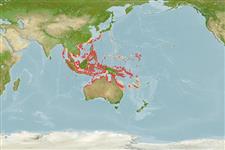>
Ovalentaria/misc (Various families in series Ovalentaria) >
Pomacentridae (Damselfishes) > Pomacentrinae
Etymology: Hemiglyphidodon: Greek, hemis = the half + Greek, glyphis = carved + Greek, odous = teeth (Ref. 45335).
More on author: Bleeker.
Environment: milieu / climate zone / depth range / distribution range
Sinh thái học
Biển Cùng sống ở rạn san hô; không di cư; Mức độ sâu 1 - 20 m (Ref. 7247). Tropical; 32°N - 25°S, 92°E - 171°E
Western Pacific: Thailand (Phuket), China, Philippines, Indonesia, New Guinea, Timor Sea (Ashmore Reef), Western Australia, Great Barrier Reef, New Britain and Solomon Islands.
Bộ gần gũi / Khối lượng (Trọng lượng) / Age
Maturity: Lm ? range ? - ? cm
Max length : 18.0 cm TL con đực/không giới tính; (Ref. 48636)
Các tia vây lưng cứng (tổng cộng): 13; Các vây lưng mềm (tổng cộng): 14-15; Tia cứng vây hậu môn 2; Tia mềm vây hậu môn: 14 - 15.
Adults occur in protected lagoon and coastal reefs around branching corals (Ref. 9710), usually with lots of algae on coral bases on the substrate (Ref. 48636). Feed on algae (Ref. 1602). Large species, to at least 18 cm (Ref. 48636). Oviparous, distinct pairing during breeding (Ref. 205). Eggs are demersal and adhere to the substrate (Ref. 205). Males guard and aerate the eggs (Ref. 205). Diurnal species (Ref. 113699).
Life cycle and mating behavior
Chín muồi sinh dục | Sự tái sinh sản | Đẻ trứng | Các trứng | Sự sinh sản | Ấu trùng
Oviparous, distinct pairing during breeding (Ref. 205). Eggs are demersal and adhere to the substrate (Ref. 205). Males guard and aerate the eggs (Ref. 205).
Allen, G.R., 1991. Damselfishes of the world. Mergus Publishers, Melle, Germany. 271 p. (Ref. 7247)
IUCN Red List Status (Ref. 130435)
Warning: mysqli::__construct(): (HY000/1040): Too many connections in /var/www/html/includes/func_getlabel.php on line 46
Can't connect to MySQL database (fbapp). Errorcode: Too many connections
